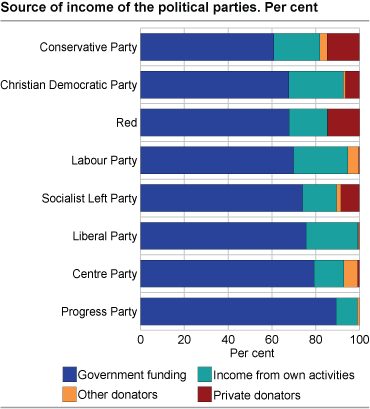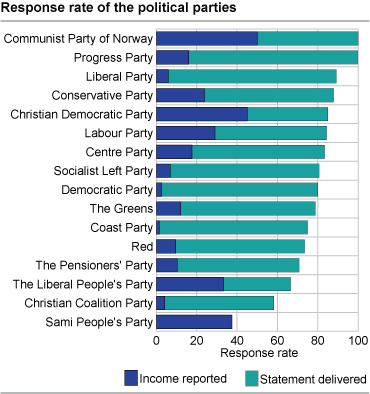Content
Published:
This is an archived release.
Government funding main source of income
Government funding accounted for 72 per cent of the political parties' income in the between-elections year 2008; the same share as in the corresponding year 2006. The proportion was highest for the Progress Party and smallest for the Conservative Party.
More than three out of four of the party organisations reported that - excluding government funding - they had an income of below NOK 10 000. The 682 party organisations that reported having an income of at least NOK 10 000 each, reported to have received almost NOK 470 million in total, of which government funding accounted for NOK 340 million. A total of 51 per cent of the organisations of the Christian Democratic Party reported having an income of more than NOK 10 000, whereas only 6 and 7 per cent respectively of the organisations of the Liberal Party and Socialist Left Party reported likewise.
Election results decide governmental funding
The governmental funding was mainly given as political party subsidies from the central government. For municipality and county organisations, the party subsidies in 2008 were calculated by using the results of the local elections in 2007. Correspondingly, the subsidies for the main organisations of the political parties were calculated by using the results of the parliamentary election in 2005. The Labour Party received most governmental funding in real terms in 2008, NOK 108 million, although the Progress Party, which received NOK 64 million, had the highest share of government funding since this represented 89 per cent of the party’s total income. The Conservative Party received the smallest share as governmental funding; 61 per cent of its total income.
Labour organisations and the Labour Party
The NOK 5.7 million that the Labour Party received from labour organisations made up about 4 per cent of the party's total income. In total, 79 per cent of the party contributions from the labour organisations went to the Labour Party, while 11 and 10 per cent went to the Centre Party and Socialist Left Party respectively.
Private donations to the Conservative Party and the Christian Democratic Party
The Conservative Party received almost NOK 13 million and the Christian Democratic Party NOK 2.7 million from private donations in 2008, which represented 15 and 6 per cent of the parties' total income. A total of 73 per cent of all private donations were donated to these two parties. Socialist Left Party and Red received 21 per cent, mainly as party fees paid by elected representatives.
Income from own activities for the Labour Party and the Conservative Party
Capital income accounted for NOK 7 million of the Labour Party’s income and NOK 5.3 million of the Conservative Party's income. This represented 6 per cent of the latter party’s total income.
Lotteries, bingo, slot machines and fund raising also made up a substantial part of the income, accounting for more than NOK 11 million or 7 per cent of Labour's income. For the other larger parties, this source of income varied from 0.1 to 12 per cent of the total income. The Liberal Party saw the highest proportion, while the Socialist Left Party had the lowest.
Highest membership fees reported by the Conservative Party
The Conservative Party reported having received NOK 4 million or 4.6 per cent of the total income in membership fees in 2008. The Centre Party, Christian Democratic Party and Liberal Party reported the highest share of their total income from membership fees, some 8 per cent. For The Liberal People’s Party, which has not received any government funding, membership fees constituted almost 90 per cent of the total income. The Communist Party of Norway received 43 per cent of its total income from this source.
More detailed figures are published on www.partifinansiering.no
Capital incomeComprises capital gains and dividends. About the dataPursuant to the Political Party Act, which came into force in 2005, all registered political parties must report their income every year. The report should give a complete overview of the political party’s income, distributed by source of income. The main sources are government subsidies, income from activities and external donations. The report should also contain a list of major contributors and contributors with which the political party has made a written agreement in political or business matters. Political organisations with less than NOK 10 000 in total income (excluding government subsidies) do not have to report their income, but need to provide a statement saying so is the fact. 2006 was the first year with this type of reporting. The statistics presented here are based on reports submitted in 2009. The deadline was 1 July, and 85 per cent of the party organisations submitted their reports by this date; 2 805 party organisations of the total 3 291. The figures now presented are based on the reports from all the 3 119 party organisations that had responded by 25 August, giving a response rate of 95 per cent. The figure at the bottom presents the response rate as of 1 July and also shows whether the party organisations had reported income above the NOK 10 000 limit including a breakdown of that income, or whether they had reported their income as below NOK 10 000. The data comprise all registered political parties. Since this is a relatively new data source, there may be uncertainties in the data. The main uncertainty is about whether the income is reported on the correct source, or whether the income is gross income and not net, and whether all the income has been reported. Non-response and exemption due to low income are also sources of uncertainty. |
Tables:
- Table 1 Funding of political parties, by source of income and political party. 2008
- Table 2 Funding of political parties, by source of income and political party. 2008. Per cent
- Table 3 Main organization only. Contributions from labour organizations, enterprises, organizations etc. 1998-2008. NOK 1 000
Contact
-
Terje Risberg
E-mail: terje.risberg@ssb.no
tel.: (+47) 92 62 81 09
-
Tove Bergseteren
E-mail: tove.bergseteren@ssb.no
tel.: (+47) 99 79 08 19
-
Statistics Norway's Information Centre
E-mail: informasjon@ssb.no
tel.: (+47) 21 09 46 42


